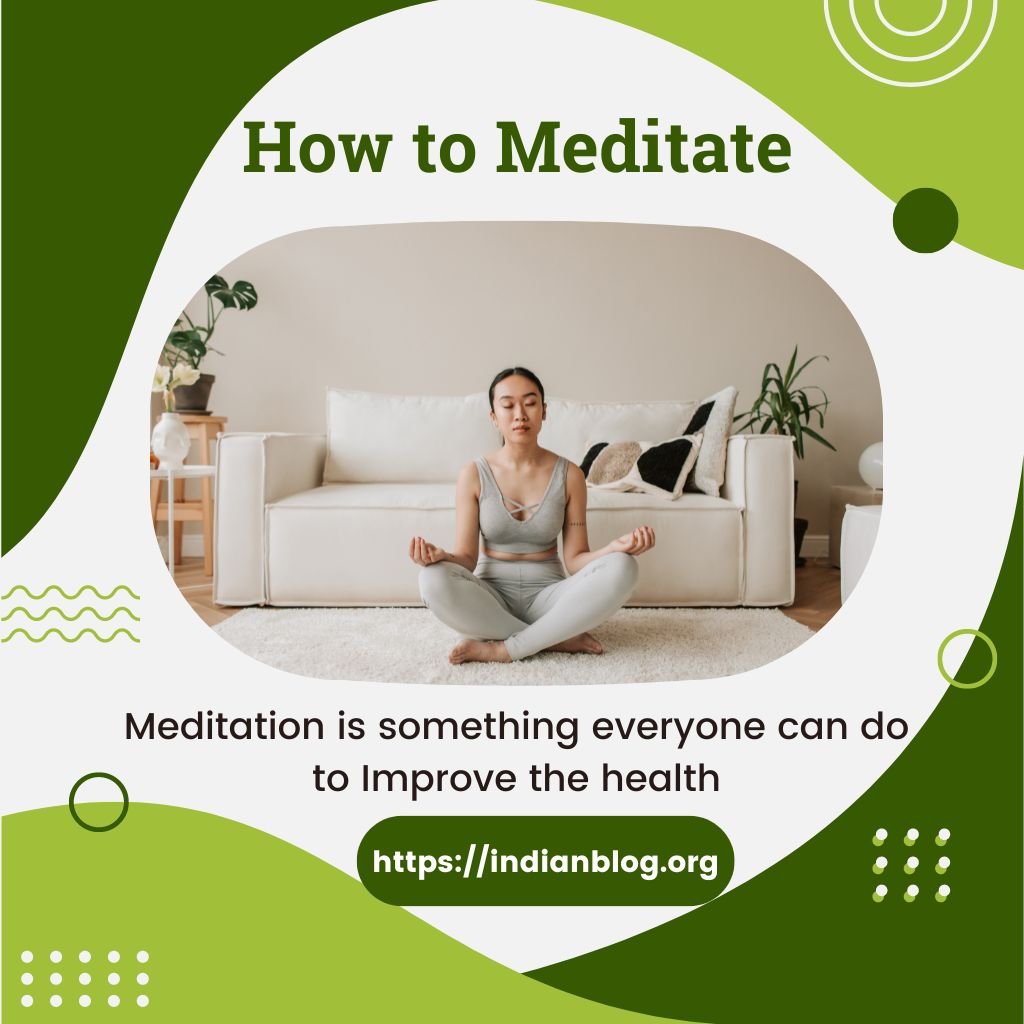The power of meditation in improving the mental and physical well-being is well known. Meditation has been practiced for thousands of years, and with good reason, even meditations are the part of many religious practices and knowingly or unknowingly everyone practicing some amount of meditation as their routine life. This ancient practice has been proven to have a wide range of benefits for both the mind and the body. From reducing stress and anxiety to improving focus and concentration, meditation can be a powerful tool for improving overall well-being.
Meditation is a powerful tool for improving mental and physical well-being. It can help to reduce stress and anxiety, improve focus and concentration, boost the immune system and help to improve self-awareness and self-acceptance. If you’re looking to improve your overall well-being, give meditation a try and see the difference it can make in your life.
One of the main benefits of meditation is its ability to reduce stress and anxiety. When we are feeling stressed or anxious, our bodies release hormones such as cortisol and adrenaline, which can have negative effects on our physical and mental health. Meditation helps to reduce the release of these hormones and promote feelings of relaxation and calm.
Meditation can also help to improve focus and concentration. When we meditate, we are training our minds to be more present and aware of the present moment. This can help us to be more focused and productive in our daily lives. Meditation has also been shown to have physical health benefits. Research has found that regular meditation can lower blood pressure, improve sleep, and even boost the immune system. Another benefit of meditation is that it can help to improve self-awareness and self-acceptance. When we meditate, we are able to observe our thoughts and emotions without judgment. This can help us to understand ourselves better and develop a more positive self-image.
One of the great things about meditation is that it is accessible to anyone, regardless of age, religion, or background. There are many different types of meditation, such as mindfulness meditation, loving-kindness meditation, and transcendental meditation, so it’s easy to find one that works for you.
If you’re new to meditation, it’s important to start slowly. Try to set aside just a few minutes a day to meditate. You can start with a simple breathing exercise and gradually increase the time as you become more comfortable with the practice.
Types of Meditation
There are many different types of meditation, each with their own unique focus, techniques, and benefits. Some of the most popular types of meditation include:
- Mindfulness meditation: This type of meditation involves paying attention to the present moment, without judgment. This can be done by focusing on the breath, a word or phrase, or a physical sensation in the body. Mindfulness meditation can help to reduce stress and anxiety, improve focus and concentration, and increase self-awareness.
- Mindfulness-based stress reduction (MBSR) meditation: This type of meditation is a clinically-proven program that involves a combination of meditation, yoga, and mindful movement to reduce stress and improve overall well-being.
- Yoga meditation: This type of meditation is rooted in yoga philosophy and involves a combination of physical postures, breath control, and visualization to improve overall well-being. Yoga meditation can help to improve flexibility, strength, balance, and relaxation..
- Loving-kindness meditation: This type of meditation involves focusing on feelings of love and compassion towards oneself and others. This can be done by repeating phrases such as “may you be happy, may you be healthy, may you be at peace.” Loving-kindness meditation can help to increase feelings of compassion and empathy, and promote positive relationships.
- Guided meditation: This type of meditation is led by a guide, who may use visualization, imagery, or spoken word to help the meditator to focus and to relax. Guided meditation can be useful for those who find it difficult to focus or to relax.
- Guided imagery meditation: This type of meditation involves listening to a guided voice that leads you through a peaceful scene or story to help you relax and focus your mind.
- Transcendental meditation: This type of meditation involves using a mantra, or a sound or word, to help the mind to focus and to reach a state of transcendence. Transcendental meditation is a simple, natural technique that allows the active mind to settle down and experience inner peace by reaching in a state of deep relaxation.
- Chakra meditation: This type of meditation involves focusing on the body’s seven main chakras, or energy centers, to balance the body’s energy and improve overall well-being. Chakra meditation can help to balance the body’s energy and promote overall well-being.
- Breath awareness meditation: This type of meditation involves focusing on the breath and becoming aware of its natural flow.
- Zen meditation: Also known as Zazen, this type of meditation involves focusing on the breath and maintaining a specific posture, typically sitting cross-legged on a cushion. This type of meditation is rooted in Zen Buddhism and involves sitting in silence and focusing on the breath to cultivate mindfulness and inner peace. Zen meditation can help to improve focus and concentration, and increase self-awareness.
- Christian meditation: This type of meditation involves using Christian-based practices such as contemplative prayer, reading scripture, and visualization to improve spiritual connection and inner peace.
- Islamic meditation: This type of meditation is rooted in Islamic tradition and involves practices such as Zikr, Pray, etc.
- Body scan meditation: This type of meditation involves paying attention to different parts of the body, starting at the toes and working up to the head, to become more aware of sensations and release tension.
- Concentration meditation: This type of meditation involves focusing the mind on a specific object, image, or sound to improve concentration and focus.
- Kundalini meditation: This type of meditation involves specific breathing techniques and movements to activate the kundalini energy, which is believed to be located at the base of the spine.
- Movement meditation: This type of meditation involves incorporating gentle movement or walking with the focus on breathing and mindfulness.
- Qigong meditation: This type of meditation combines movement, breathing techniques, and visualization to balance and cultivate the body’s qi (energy).
- Sound meditation: This type of meditation involves listening to specific sounds or music to improve focus and relaxation.
- Vipassana meditation: This type of meditation involves observing one’s thoughts and feelings with non-judgmental awareness to gain insight into the nature of reality.
- Mantra meditation: This type of meditation involves repeating a specific word or phrase, such as “Om” or “peace,” to help focus the mind and reach a meditative state.
- Dynamic meditation: This type of meditation involves a combination of movement, breath work, and music to release emotional blockages and increase energy levels.
- Yoga nidra: This type of meditation is also known as “yogic sleep” and involves guided relaxation and visualization to reach a state of deep relaxation and rejuvenation.
- Taoist meditation: This type of meditation is rooted in Taoist philosophy and involves practices such as visualization, breath control, and movement to cultivate inner energy and balance.
- Pranayama meditation: This type of meditation involves specific breathing techniques to control and regulate the flow of prana, or life force energy, in the body.
- Shikantaza meditation: This type of meditation is considered a form of Zen Buddhism and involves sitting and simply being present without any specific focus or goal.
- Sufi Meditation: This type of meditation is rooted in Sufi tradition and involves practices such as chanting, repetition of God’s name and dance to reach a state of spiritual enlightenment.
- T’ai chi meditation: This type of meditation involves slow and fluid movements, combined with breathing and visualization, to balance the body’s energy and improve overall well-being.
- Visualization meditation: This type of meditation involves creating mental images or scenes to focus the mind and reach a meditative state.
These are just a few examples of the many different types of meditation available. There are many different types of meditation practices, and new ones can be created too, each with their own unique focus, techniques, and benefits. Some of them can be specific to a certain culture, tradition or belief. It’s important to explore and find the one that best suits your needs and preferences.
Religious and Non-religious Meditation
Meditation can be practiced within different religious or spiritual traditions or as a secular practice. It’s important to note that different people may practice the same type of meditation in different ways, and that some practices may have different names in different cultures or traditions. Here are some examples of religious and non-religious meditations:
Religious Meditations
- Islamic meditation: This type of meditation is rooted in Islamic tradition and involves practices such as Zikr, Salah (pray), etc.
- Buddhist meditation: This type of meditation is rooted in Buddhism and involves practices such as mindfulness, loving-kindness, and insight meditation to cultivate inner peace and understanding of the nature of reality.
- Hindu meditation: This type of meditation is rooted in Hinduism and involves practices such as yoga, mantra repetition, and visualization to achieve spiritual enlightenment and union with the divine.
- Christian meditation: This type of meditation involves using Christian-based practices such as contemplative prayer, reading scripture, and visualization to improve spiritual connection and inner peace.
- Jewish meditation: This type of meditation is rooted in Judaism and involves practices such as Kabbalah, study of the Torah, and visualization to achieve spiritual enlightenment.
Non-religious Meditations
- Mindfulness meditation: This type of meditation involves paying attention to the present moment and cultivating awareness of one’s thoughts, feelings, and surroundings without any spiritual or religious connotation.
- Transcendental meditation: This type of meditation involves the use of a mantra or sound to focus the mind and reach a state of deep relaxation and inner peace, without any religious connotation.
- Yoga nidra: This type of meditation is also known as “yogic sleep” and involves guided relaxation and visualization to reach a state of deep relaxation and rejuvenation, without any religious connotation.
- Vipassana meditation: This type of meditation is a form of insight meditation that focuses on developing self-awareness and understanding of the nature of reality, without any religious connotation.
- Loving-Kindness meditation: This type of meditation involves cultivating feelings of love, kindness, and compassion towards oneself and others, without any religious connotation.
Are you ready to pitch your content on the Indian Blog? Submit your guest post here.

